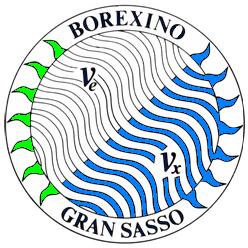
Research: BOREXINO
Real-time solar neutrino spectroscopy at low energies
Solar neutrinos and Borexino's role
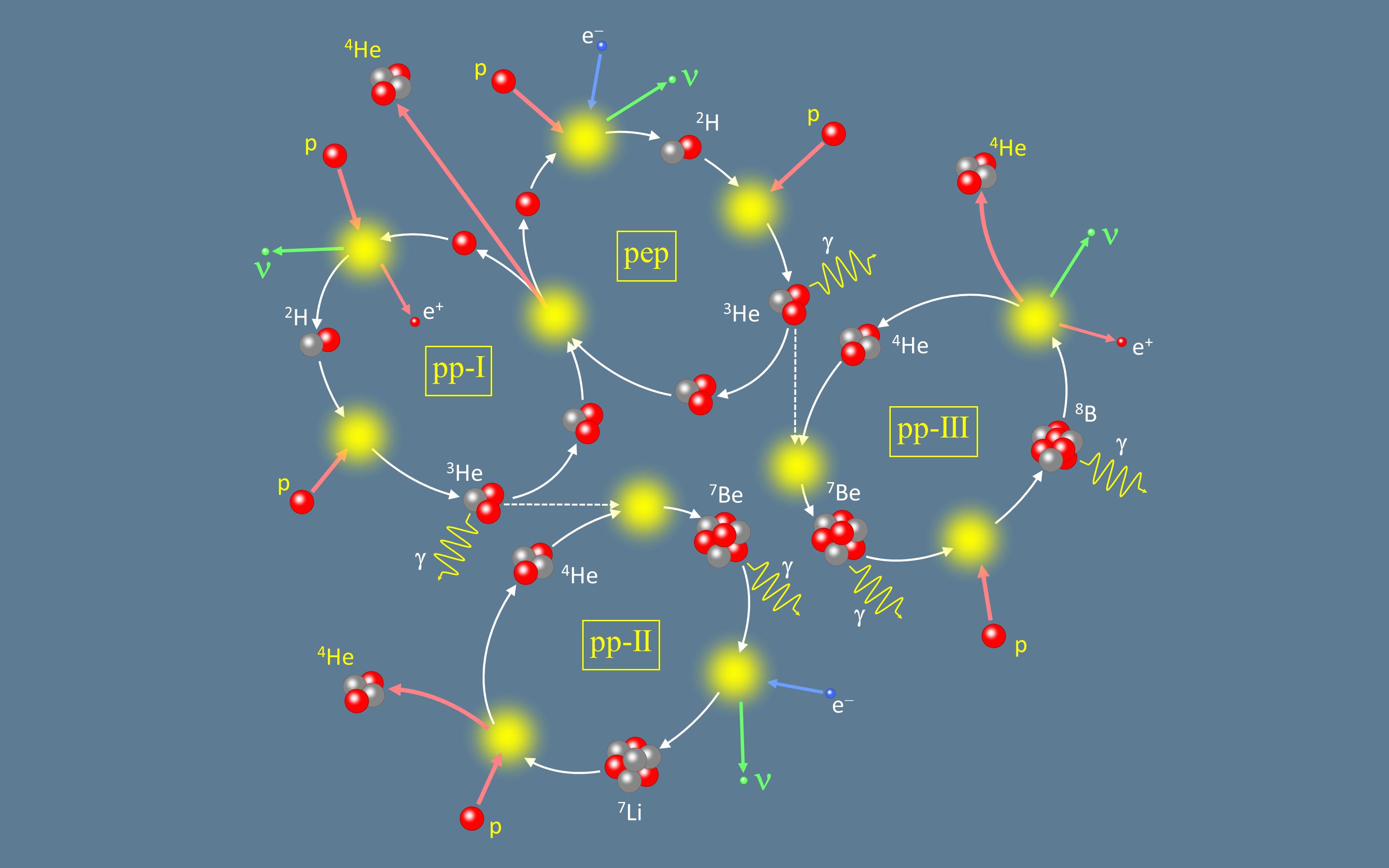
Figure 1: pp chain.
The nuclear fusion of four hydrogen atoms to one helium nucleus is responsible for the immense energy release from our Sun over billions of years. The Standard Solar Model (SSM) predicts that this overall fusion process occurs mainly via the so-called pp chain (98%), part of which is depicted in Figure 1. In the residual cases the energy is emitted in the catalytic CNO cycle. In stars with higher internal temperatures and higher masses the CNO cycle becomes dominant. That is the reason why the astrophysics community is also very interested in exploring this production channel in our Sun. Due to conservation of fundamental physics laws the fusion reactions do not only release a high energy of 26 Mega-electronvolts (MeV) in terms of light, but also 2 positrons and 2 neutrinos. Neutrinos are electrically neutral elementary particles, which exist in 3 flavors: electron, muon and tau neutrino. In case of the Sun, all released neutrinos are of the electron type. The weak interaction with matter allows neutrinos to escape the solar interior at almost speed of light and preserving the information about their origin. So, neutrinos are ideal probes for testing predictions of solar models.
Observations with all past and current solar neutrino detectors have shown a significant deficit in the measured electron neutrino flux compared to the theoretical predictions of solar models ('Solar Neutrino Problem'). This deficit was finally explained by a partial flip of the electron neutrinos into other neutrino types ('neutrino oscillations'), both during the propagation through the interstellar vacuum as well as enhanced by the presence of the high electron density inside the Sun ('Mikheyev-Smirnov-Wolfenstein (MSW) effect'). This discovery proofed the massive character of neutrinos, which were predicted to be massless by the standard paradigm of elementary particle physics. As a consequence the interest for searching new physics beyond it increased rapidly over the last two decades. From experimental point of view, solar neutrino experiments have continued to help defining the neutrino mass properties. The predicted solar neutrino spectrum covers a wide range up to 18 MeV, however 99% of solar neutrinos have endpoint energies E below 2 MeV: pp neutrinos have E < 0.42 MeV,
7Be neutrinos E = 0.38 MeV and E = 0.86 MeV, pep neutrinos E = 1.44 MeV, and the CNO neutrinos have E < 1.73 MeV. Comparing to all other previous and still running solar neutrino experiments, Borexino is the first and unique experiment world-wide able to detect several of these components individually, in real-time and with high statistics.
Borexino detects neutrinos via their elastic scattering with electrons in the organic molecules of the scintillator. The detection of the expected number of solar neutrino interactions (few events for pep and CNO, few tens of events for
7Be, and about 150 events for pp) per day per 100 tons of scintillator sets stringent requirements to the allowed background levels due to cosmic-radiation as well as environmental natural radioactivity.
For these reasons, the Borexino detector has a graded shielding profile and was built in the National Underground Laboratory at Gran Sasso (LNGS) of INFN after several years of R&D (more info on the history of Borexino can be found
here). The overburden of the Gran Sasso dolomite massiv is 1.4 km thick. Thanks to it the muon flux is reduced by 6 orders of magnitude to about 1.2 muons/h/m
2. In order to further reduce the residual cosmic-ray flux the Borexino Inner Detector (see Figure 2) was surrounded by an Outer Detector. It is a domed steel tank with 16.9 m of height and 18.0 m diameter which is equipped with 208 photomultiplier tubes (PMTs) and filled with 2100 tons of ultra-pure deionized water. It allows to detect Cherenkov light generated by the residual cosmic particles and, moreover, to moderate and absorb neutrons emitted from the rock.
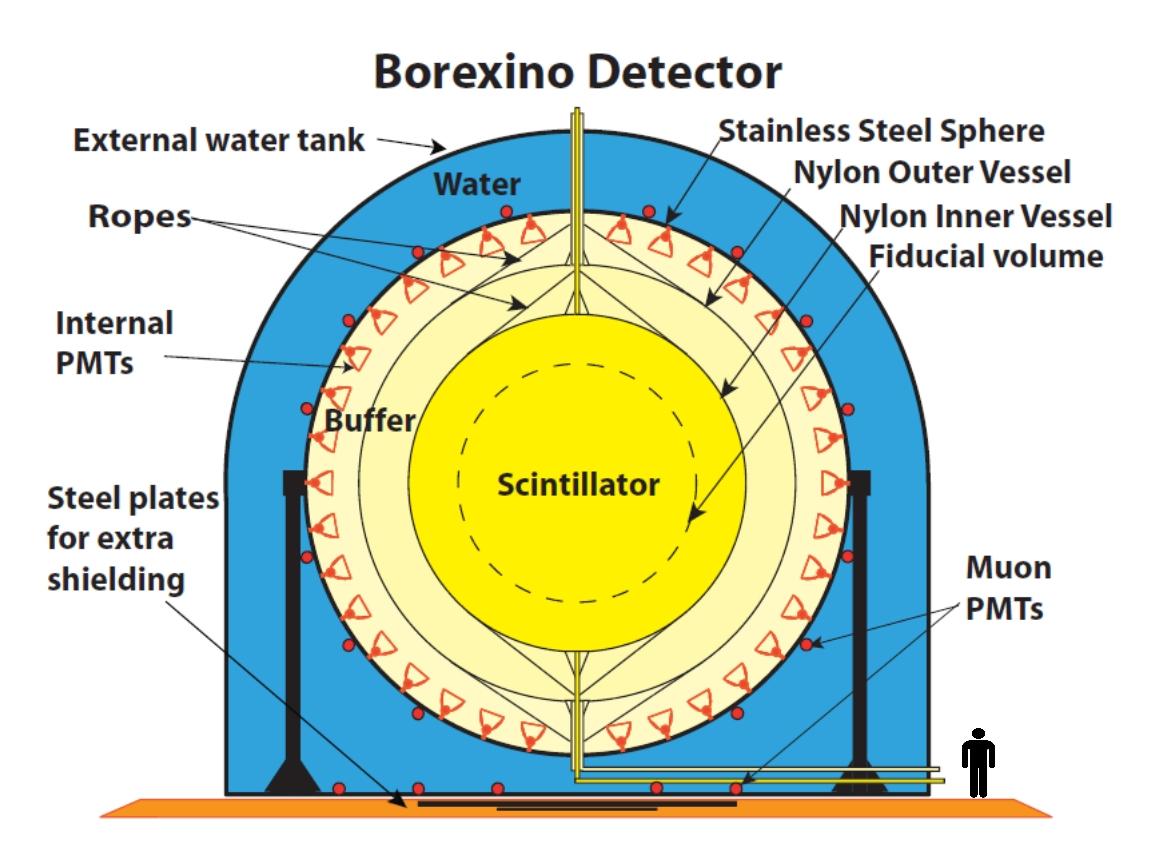
Figure 2: Borexino setup.
The Inner Detector contains organic liquids in three different subvolumes which are separated by two transparent nylon vessels. The two outer-most shells contain 890 tons (1350 m
3) of pseudocumene (PC) with few grams/l of the light quencher DMP. These buffer vessels act as absorber of external radiation and as Radon barriers. Within the inner-most nylon balloon (100 micrometers thick, 8.5 m in diameter) 278 tons (315 m
3) of an ultra radiopure scintillator constitute the core of the experimental apparatus. The scintillator is a mixture of pseudocumene (PC) and 1.5 g/l of PPO (a fluorescent molecule). The light induced by incident neutrinos as well as background events in the scintillator is viewed by 2212 PMTs which are mounted on the inner surface of the SSS and are pointing towards the detector's center.
The graded-shield of progressively lower intrinsic radioactivity towards the center culminates in powerful background identification and rejection techniques applied offline on the collected data. For instance, the ability to reconstruct the position of events, allows to apply a virtual space cut and use only the most internal 100 tons fo the scintillator ('Fiducial Volume') while the surrounding 200 tons are used as additional shield. Moreover, the reconstruction of the position and energy of events and their time stamp allows to search for coincidences induced by contaminants (e.g. Bi-Po coincidences from U/Th decay chain, or the cosmogenic radioisotopes
11C that can be tagged and rejected via a threefold-coincidence (TFC) method). Finally, pulse shape discrimination techniques have been successfully developed to reject e.g. alpha particles or to distinguish decays emitting either positrons or electrons.
Physics Program: Results and Future Prospects
Since the Borexino Collaboration widely succeeded to fulfill the radiopurity requirements, a rich physics program has been addressed, spanning from solar and geo-neutrino detection to the search for supernova and sterile neutrinos. A brief overview is given below.
Solar Neutrinos
7Be neutrinos
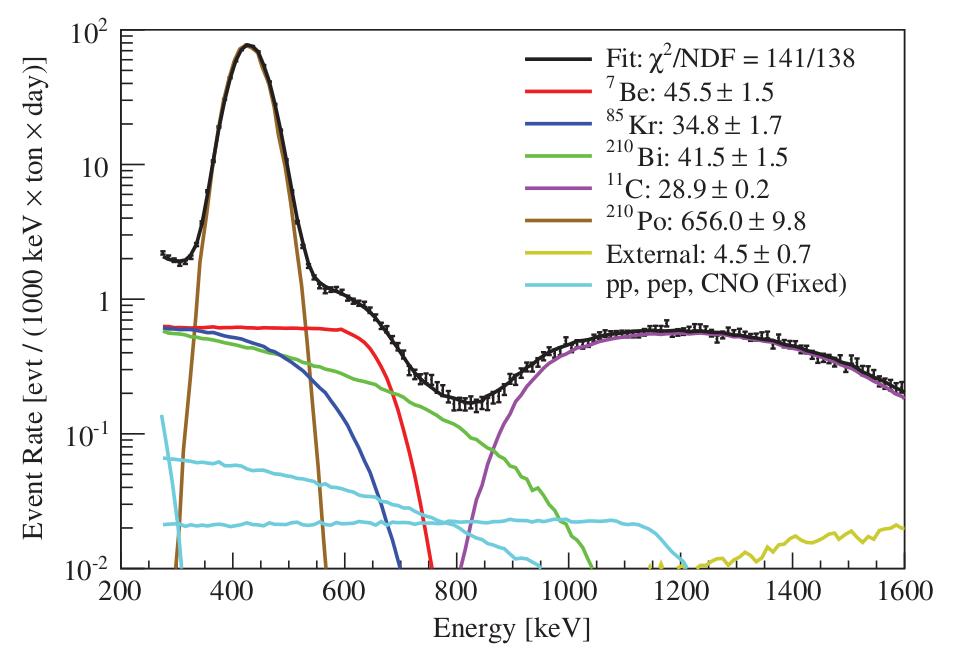
Figure 3: 7Be Neutrinos.
The main goal of the Borexino experiment has been the precise measurement of the monoenergetic
7Be neutrino rate. The signature of these neutrinos is a Compton-like edge at an energy of 0.7 MeV. The most recent evaluation includes 3 years of data-collection and its spectrum is shown in Figure 3;
7Be neutrinos and the main background components are free parameters, while the contribution of solar pp, pep and CNO neutrinos were fixed. The measured rate of (46±1.5(stat)±1.5 (sys)) counts/day/100 ton is in well agreement with the expectations of the SSM including the neutrino oscillations scenario. Recently, the Borexino collaboration studied the annual modulation of the solar neutrino flux due to Earth's eccentricity by means of the
7Be neutrino rate. A difference of 7% was expected. The absence of a modulation was rejected with high significance (more than 3 sigma).
8B Neutrinos
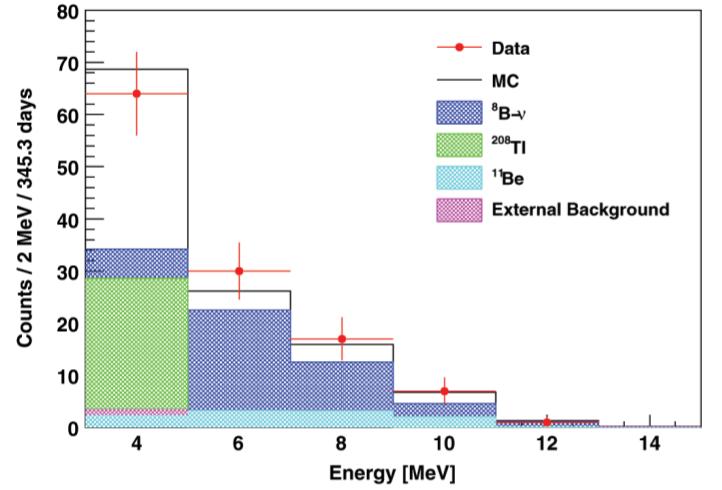
Figure 4: 8B Neutrino Spectrum
Borexino succeeded also to measure the 8B neutrino rate with an unprecedented low energy threshold of 3.0 MeV which is right above the highest energetic gamma-rays from natural radioactivity. The measured rate of (0.22±0.04(stat)±0.1(sys)) counts/day/100 ton is in good agreement with measurements from the previous solar neutrino experiments SNO and SuperKamiokaNDE. These two pioneering experiments used successfully large Water Cherenkov detectors to measure solar neutrino interactions, however the energy threshold in those cases was only around 4.5 MeV.
pep neutrinos
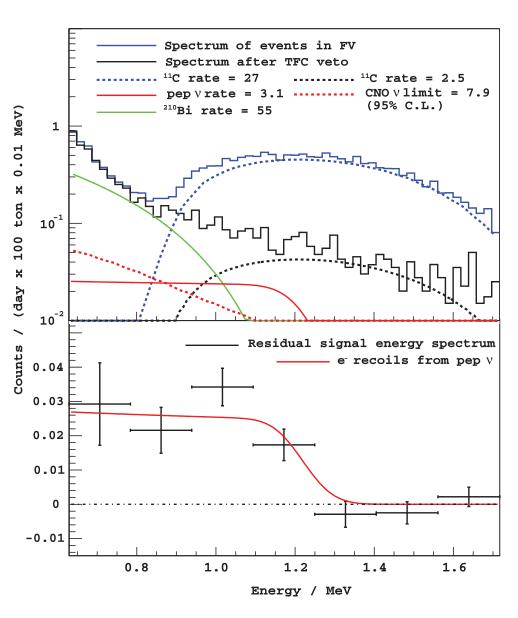
Figure 5: pep neutrinos
The main obstacle for the detection of solar pep neutrinos in Borexino are radioactive decays of muon-induced
11C atoms. Their rate is 10 times higher than the expected underlying neutrino signal. Two powerful techniques were developed to identify and reject this background. The first method is based on a threefold-coincidence (TFC): In about 95% of cases
11C is produced by cosmic-rays (muons and muon-induced hadronic showers) through the reaction: muon +
12C → muon +
11C + n. The kicked-off neutron is absorbed in the scintillator shortly after (capture time: 255 microseconds) under emission of a characteristic 2.2 MeV gamma-ray. The
11C nuclide decays with a lifetime of 30 minutes into
11B plus a positron (e
+, antiparticle of the electron) and an electron-neutrino. The coincidence among muon, neutron and
11C decay allows to tag
11C candidates and to apply efficiently space cuts inside the Fiducial Volume for well-defined time periods. On this way, it is possible to reduce the
11C background by 90% while loosing only 50% of the collected statistics (upper plot in Figure 5). The second method looks for small differences in the pulse shape of events induced by positron (such as
11C) and electron emitters (such as neutrino-induced interactions). The technique allowed to reject most of the residual
11C background (lower plot in Figure 5). In this way, Borexino was able to measure for the first time directly the pep rate, namely (3.1±0.6(stat)±0.3(sys)) counts/day/100 ton.
pp neutrinos
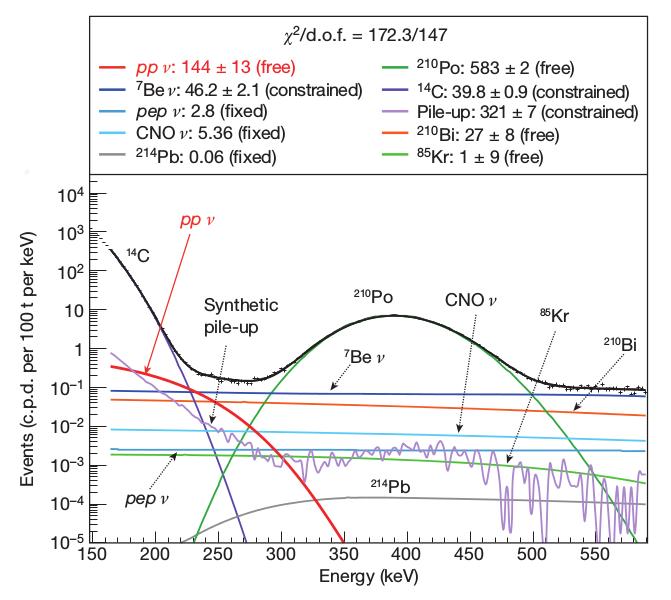
Figure 6: pp neutrinos
The most recent analysis focused on the first direct detection of pp neutrinos which constitute almost 98% of the entire solar neutrino flux. The pp neutrinos have an endpoint energy of 0.42 MeV. Two main requirements for measuring them had to be fulfilled. First, the
85Kr continuous background had to be reduced. This was achieved after an extensive purification of the scintillator lasting more than one year. Second, the background induced by
14C decays had to be characterized and quantified.
14C is an intrinsic contaminant in the organic liquid mixure with endpoint energy at 0.25 MeV, which cannot be removed by any purification method. Since its trigger rate is so high, it often leads to pile-up events, whose spectral shape is a priori not known. Against expectations, Borexino succeeded to deduce the spectral shape of the
14C beta spectrum and its pile-up and finally to measure the pp neutrinos. The rate of (144±13) counts/day/100 ton is in good agreement with expectations of the SSM and neutrino oscillations. Moreover, the neutrino rate can be used to infer the expected solar luminosity. Because neutrinos can cross the Sun within seconds and photons produced in the Sun’s core take a very long time (at least several 10,000 years) to reach the surface, neutrino and optical observations in combination provide experimental confirmation that the Sun has been in thermodynamic equilibrium over such a timescale.
Geo- and reactor-antineutrinos
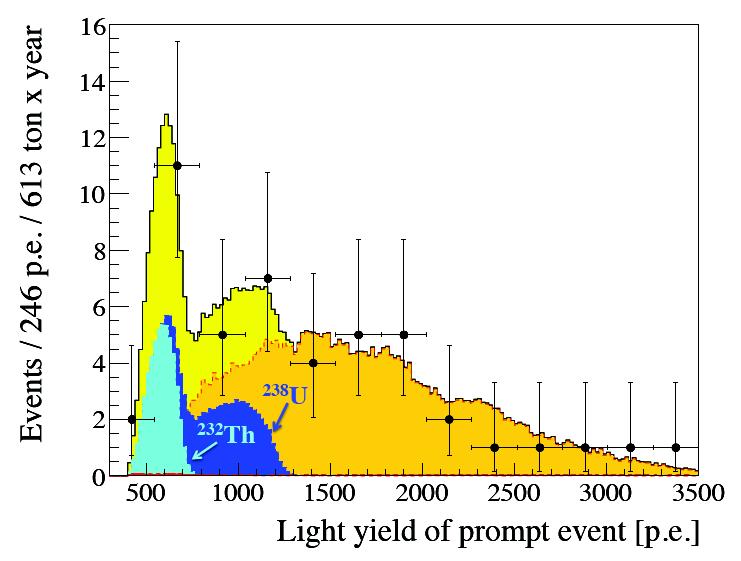
Figure 7: Geo-neutrinos
The so-called Bulk-Silikate Earth (BSE) model predicts the origin and size of radiogenic heat released in the Earth's interior and which coincides with the averaged value at surface by integrating over worldwide 40,000 deep bore-holes measurements. The heat is generated by decays of mainly U/Th. These decays are accompanied by a large number of anti-neutrinos (called 'geo-neutrinos') which can be detected by Borexino via the coincident inverse beta decay reaction: ν + p → n + e
+. On the other hand, cosmic-ray induced backgrounds, anti-neutrinos from European reactor plants and U/Th daughter nuclides (mainly
210Po) persist and have to be rejected. Borexino succeeded in this and measured (14.3±4.4) cts/100 ton within 1.7 years of life time. The value is in agreement with predictions of many BSE sub-models. In addition, the measured energy spectrum (Figure 7) allowed for the first time to separate the U from the Th content.
Future prospects in 2015 and beyond
Solar CNO neutrinos
The remaining neutrino flux among the 'Big Five' that has not yet been directly detected by any experiment is the one from the CNO cycle. So far, Borexino set the most stringent limit, i.e. < 7.9 counts/day/100 ton which is still 1.5 times higher than the SSM prediction.
At the moment of writing, the Borexino collaboration is attempting to determine directly the CNO neutrino rate. Besides the already mentioned
11C background, the major obstacle for the measurement is given by the unknown rate of
210Bi decays. Unfortunately, the concentration of the mother nuclid
210Pb is not in secular equilibrium with the decay product of
210Bi, namely
210Po. New quantities of
210Po atoms are often reintroduced in the scintillator during operations on the liquids. Several methods are under development to characterize the change in time of these tracers.
It's worth to mention that the measurement of the CNO neutrino rate will not only be useful for extrapolation to the models of other stars, but also to solve a more recent mismatch between the updated SSM and helioseismology predictions ('Metallicity problem'). Since the CNO neutrino flux would be strongly affected (29–40%) by the latest modifications of the SSM, a precise measurement will help to solve the problem.
Sterile neutrino search
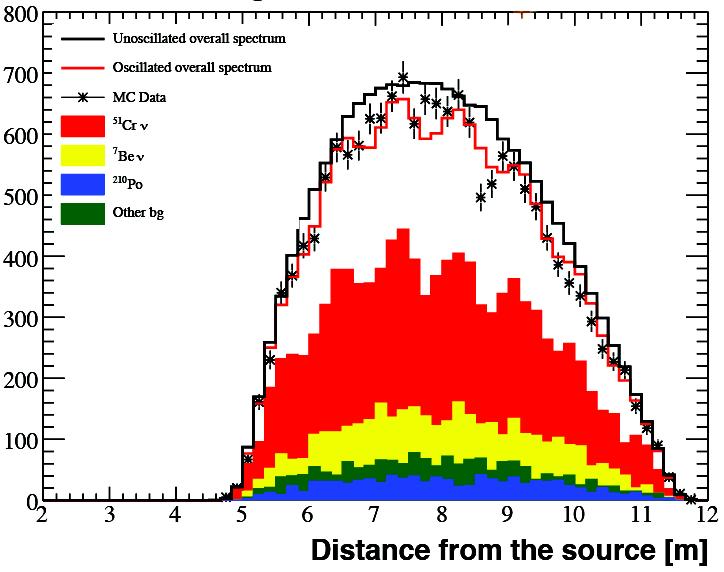
Figure 8: 51Cr sterile neutrino signature in BX
Anomalies observed in several ground-based neutrino-beam experiments (LNSD, MiniBooNE) as well as deficits in anti-neutrino fluxes at short distances (10 m) measured in gallium and reactor experiments have suggested the existence of a fourth type of neutrino called 'sterile neutrino'. To confirm/rule out the hypothesis of such a new elementary particle a neutrino source experiment with Borexino is planned. The project called Short-distance Oscillation in BoreXino (SOX) forsees the deployment of high activity artificial neutrino (
51Cr) and antineutrino (
144Ce) generators externally to the Borexino detector at 8.25 m from its center. The expected oscillation pattern of the new type of neutrino in this configuration for the
51Cr devise is shown in Figure 8.
Supernova neutrinos and gamma-ray burst signals
Stars collapsing at the end of their life – so-called 'supernovae (SN) – release large amounts of light and neutrinos/antineutrinos. Only 3–4 supernovae per century are expected within our Galaxy. Since neutrinos travel at almost speed of light, and since the light emitted by the supernova is delayed by crossing the expanding stellar remnants, SN neutrinos typically reach the Earth earlier than the light. Thus, the early detection of SN neutrinos can be used to alert light detecting telescopes. This will help to measure the entire light curves of such cosmic explosions in different spectral bands. For this reason, a world-wide early warning network (called SNEWS) of large volume neutrino detectors has been established, whom also Borexino belongs to for several years.
More recently, Borexino has considered to join a cooperation with other experiments, which will look for gamma-ray bursts in terms of high-energetic events and gravitational waves.
More details about the Borexino results can be found in
some selected publications.
Borexino at MPIK
The group at MPIK joined Borexino before the construction of the experiment in the late 1990. The group led previously the pioneering solar neutrino experiment GALLEX/GNO experiment and thus was able to transfer its expertise in low-background techniques to Borexino.
Extremely low concentrations of radioactive isotopes in the various detector components of Borexino were required, thus large surveys in finding radio-pure materials were mandatory. The Borexino group at MPIK largely contributed in this material selection process by means of highly sensitive gamma-ray spectrometers, but also by mass spectroscopy and Radon-emanation measurements. A special contribution was the successful finding of an almost
226Ra free nylon foil suitable for the construction of the Borexino inner vessel. This is in direct contact with the ultra-clean scintillator and thus was a very critical part of the detector. The MPIK group in Borexino was and is still responsible for the control and reduction of background caused by the decay of radioactive rare gas isotopes (
222Rn,
85Kr,
39Ar) in the scintillator and adjacent detector components. Most efforts during mainly the commissioning phase were dedicated to quality assurance of the supply chain of low argon/krypton nitrogen (LAKN2: 0.01 ppm Ar, 0.02 ppt Kr, 8 μBq/m
3 (STP)
222Rn).
A hardware component developed at MPIK is the calibration system for the outer water Cherenkov detector to identify cosmic ray muons and to reconstruct their tracks. This system allows an improved discrimination of in-situ produced muon induced isotopes (e.g.
11C,
10C, etc.) which is the main remaining backgrounds for solar pep- and CNO neutrinos. Since May 2007 the Borexino group at MPIK participates in the data collection on-site, in the data analysis and detector calibration. The analysis efforts have focused on the solar pep and CNO neutrino analysis. This includes the co-development and application of rejection techniques aiming at reducing the main background: the cosmogenic radioisotope
11C. For the description of a secondary background given by external gamma-rays from
228Th and
226Ra, the MPIK group developed a custom-made 5 MBq
228Th source and used it for two external calibration tests.
A list of Diploma and Ph.D. theses carried out at MPIK can be found
here.
The Borexino Collaboration
- Dipartimento di Fisica, Universitá degli Studi e INFN, Milano 20133, Italy
- Physics Department, Princeton University, Princeton, NJ 08544, USA
- Institut für Experimentalphysik, Universität Hamburg, Germany
- INFN Laboratori Nazionali del Gran Sasso, Assergi 67010, Italy
- Physics Department, Virginia Polytechnic Institute and State University, Blacksburg, VA 24061, USA
- Physics Department, University of Massachusetts, Amherst MA 01003, USA
- Lomonosov Moscow State University Skobeltsyn Institute of Nuclear Physics, Moscow 119234, Russia
- Department of Physics, University of Houston, Houston, TX 77204, USA
- St. Petersburg Nuclear Physics Institute, Gatchina 188350, Russia
- NRC Kurchatov Institute, Moscow 123182, Russia
- Joint Institute for Nuclear Research, Dubna 141980, Russia
- APC, Univ. Paris Diderot, CNRS/IN2P3, CEA/Irfu, Obs. de Paris, Sorbonne Paris Cité, France
- Physik Department, Technische Universität München, Garching 85747, Germany
- Kiev Institute for Nuclear Research, Kiev 06380, Ukraine
- National Nuclear Research University ”MEPhI”, 31 Kashirskoe Shosse, Moscow, Russia
- Max-Planck-Institut für Kernphysik, Saupfercheckweg 1, 69117 Heidelberg, Germany
- Dipartimento di Fisica, Universitá e INFN, Genova 16146, Italy
- M. Smoluchowski Institute of Physics, Jagiellonian University, Cracow, 30059, Poland
- Dipartimento di Chimica, Biologia e Biotecnologie, Universitá e INFN, Perugia 06123, Italy
- Istituto de Fisica Corpuscular, Valencia, E-46071, Spain
- Physics ans Astronomy Department, University of California Los Angeles (UCLA), Los Angeles, CA 90095, USA
The official webpage of the Borexino collaboration can be found
here.
Contact
-
Dr. Hardy Simgen:
Tel: +49 6221 516530
E-Mail: H.Simgen [at] mpi-hd.mpg.de
-
Dr. Werner Maneschg:
Tel: +49 6221 516287
E-Mail: W.Maneschg [at] mpi-hd.mpg.de
More Info
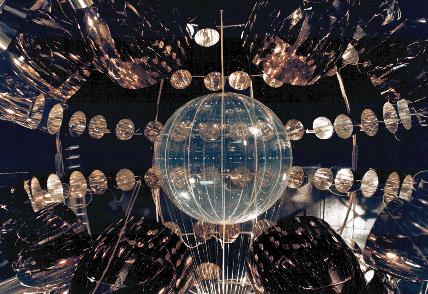
Figure 9: CTF
The history of the experiment starts in 1990, when a group of physicists envisioned a project aiming for measurements of low energy (below 2 MeV) solar neutrinos in real time. In order to get high light yield and thus a better energy resolution it was decided to use an organic liquid scintillator as detection medium. However, one had to cope with natural radioactivity (U, Th and noble gases
39Ar,
85Kr, and
222Rn) in the surrounding detector materials and in the scintillator. For the latter one the requirements were extremely high: 10
-16 g/g for U/Th and 10
-18 for
14C/
12C ratio. Since at that time it was not clear if these specifications can be fulfilled the collaboration decided to build a small-scale (4 tons active volume) pilot experiment called Counting Test Facility (CTF).
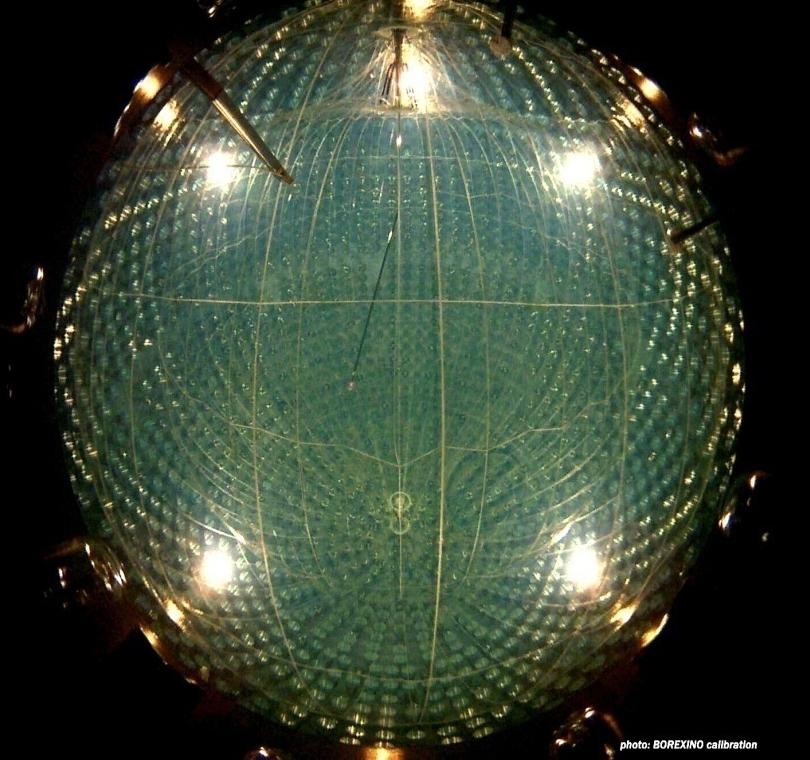
Figure 10: Borexino
Materials for the construction were carefully selected and delicate parts were mounted in a radon-free clean room. In 1995 CTF results showed the feasibility of the full-scale experiment, which was next approved by the agencies (in the years 1996–1998). In the time period of 2002–2004 the activity was stopped because of a scintillator spill accident. After restarting the operations, in spring 2006 the detector was filled with ultra-pure water, which was next replaced by approximately 300 tons of ultrapure scintillator. The filling finished on May 15, 2007, and the data collection was started immediately.
Back
-
Solar neutrinos:
- pp rate: Neutrinos from the primary proton–proton fusion process in the Sun, Nature 512 (2014), p. 383-386
- Summary of solar neutrino results from Phase I: G. Bellini et al., Final results of Borexino Phase-I on low energy solar neutrino spectroscopy, Phys. Rev. D 89 (2014) 112007
- 7Be rate @ 17%: C. Arpesella at al., First real time detection of 7Be solar neutrinos by Borexino, Phys. Lett. B 658 (2008) 101-108
- 7Be rate @ 10%: C. Arpesella at al., Direct measurement of the 7Be solar neutrino flux with 192 days of Borexino data, Phys. Rev. Lett. 101 (2008) 091302
- 7Be rate @ 5%: G. Bellini et al., Precision measurement of the 0.862 MeV 7Be solar neutrino interaction rate in Borexino, Phys. Rev. Lett. 107 (2011) 141302
- 7Be Day-night-asymmetry: G. Bellini at al., Absence of day-night asymmetry of 862 keV 7Be solar neutrino rate in Borexino and MSW oscillation parameters, Phys. Lett. B 707 (2012) 22-26
- pep rate & CNO limit: G. Bellini at al., First Evidence of pep Solar Neutrinos by Direct Detection in Borexino, Phys. Rev. Lett. 108 (2012) 051302
- 8B rate: G. Bellini at al., Measurement of the solar 8B neutrino rate with a liquid scintillator target and 3 MeV energy threshold in the Borexino detector, Phys. Rev. D 82 (2010) 033006
- Solar ν limits: G. Bellini at al., Study of solar and other unknown anti-neutrino fluxes with Borexino at LNGS, Phys. Lett. B 696 (2011) 191-196
-
Geo- and reactor-antineutrinos:
- G. Bellini et al., Observation of Geo-Neutrinos: Phys. Lett. B 687 (2010) 299-304
- G. Bellini et al., Measurement of geo-neutrinos from 1353 days of Borexino, arXiv: 1303.2571v1(hep-ex)
-
Muons and cosmogenic background:
- G. Bellini et al., Cosmic-muon flux and annual modulation in Borexino at 3800 m water-equivalent depth, Jour. Cosm. Astrop. Phys. JCAP05 (2012) 015
- G. Bellini et al., Muon and Cosmogenic Neutron Detection in Borexino: JINST 6 P05005 (2011)
-
Other rare processes:
- G. Bellini et al., New experimental limits on the Pauli forbidden transition in 12C nuclei obtained with 485 days of Borexino data, Phys. Rev. C, Vol. 81, No. 3, (2010)
- G. Bellini et al., Search for Solar Axions Produced in p(d, 3 He)A Reaction with Borexino Detector, Phys. Rev. D 85, 092003 (2012)
-
Detector and calibrations:
- G. Alimonti et al., The Borexino detector at the Laboratori Nazionali del Gran Sasso: NIM-A 600 (2009) 568-593
- H. Back et al., Borexino calibrations: Hardware, Methods, and Results: 2012 JINST 7 P10018
- Werner Maneschg, Low-energy solar neutrino spectroscopy with Borexino: Towards the detection of the solar pep and CNO neutrino flux, Ph.D. thesis (2011), Karl-Ruprecht University Heidelberg
- Davide Franco, The Borexino Experiment: Test of the Purification Systems and Data Analysis in the Counting Test Facility, Ph.D. thesis (2004), Università Degli Studi di Milano and Karl-Ruprecht University Heidelberg
- Burkhard Freudiger, Untersuchungen zu den radioaktiven Edelgasnukliden als Untergrundquelle im Sonnenneutrinodetektor Borexino, Ph.D. thesis (2003), Karl-Ruprecht University Heidelberg
- Hardy Simgen, Hochempfindlicher Nachweis radioaktiver Edelgasnuklide und natürlicher Radionuklide aus der Uran-Zerfallsreihe, Ph.D. thesis (2003), Karl-Ruprecht University Heidelberg
- Johann P. Peiffer, Das Kalibrationssystem für den äußeren Detektor des Borexino Experiments, Diploma thesis (2003), Karl-Ruprecht University Heidelberg
- Grzegorz Zuzel, 226Ra in the nylon scintillator vessel as a background source in the Solar Neutrino Experiment BOREXINO, Ph.D. thesis (2002), Jagellonian University Kraków
- Christian Buck, Radonmessungen an Teilsystemen des Sonnenneutrinoexperiments BOREXINO, Diploma thesis (2001), Karl-Ruprecht University Heidelberg
- Wolfgang Rau, Low-Level-Radonmessungen für das Sonnenneutrinoexperiment BOREXINO, Ph.D. Thesis (1999), Karl-Ruprecht University Heidelberg
- Burkhard Freudiger, Bestimmung des Radon-Gehaltes in flüssigem Stickstoff, Diploma thesis (1998), Karl-Ruprecht University Heidelberg
- Hermino Neder, Ein Low-Level-Germanium-Spektrometer: Aufbau, erste Messungen und Simulationen, Diploma thesis (1998), Karl-Ruprecht University Heidelberg
- Matthias Laubenstein, Messungen von 226Rn und 226Ra im Rahmen der Counting Test Facility des Sonnenneutrinoexperiments BOREXINO, Ph.D. thesis (1996), Karl-Ruprecht University Heidelberg